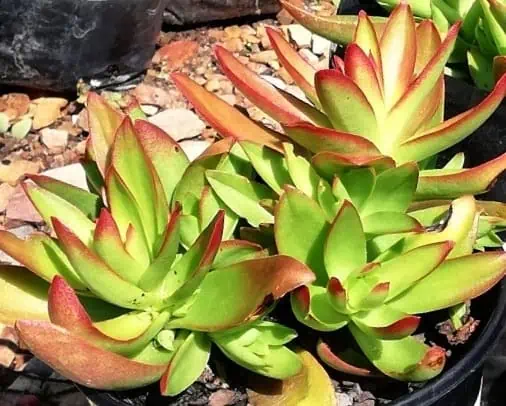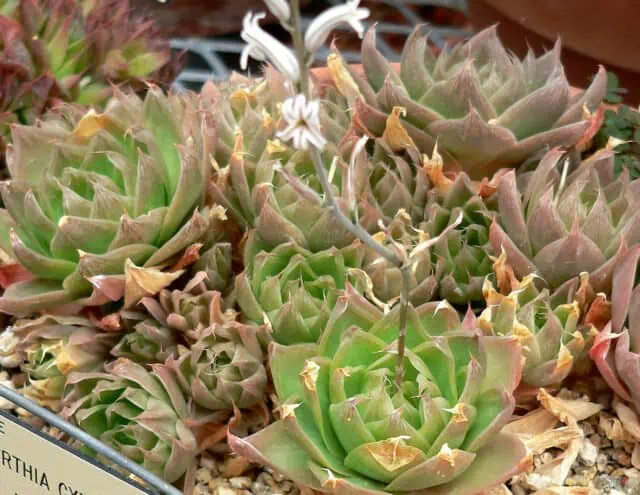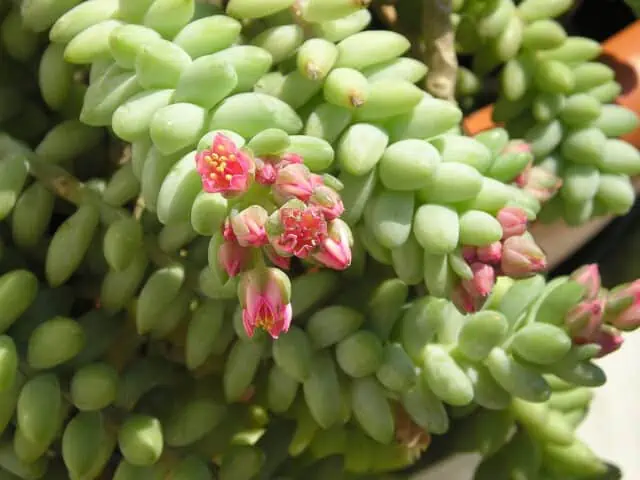Succulents can be a beautiful addition to leopard gecko tanks, but it’s essential to choose safe varieties. Many succulents are non-toxic and suitable for leopard gecko environments.
Succulent Safety: While many succulents are safe for leopard geckos, always ensure they are non-toxic before introducing them to the terrarium. Aloe Vera, for instance, is best avoided.
Care Similarities: Succulents thrive in similar conditions as leopard geckos, making them easy to care for. Both prefer arid environments and can tolerate low moisture conditions.
Natural Benefits: Introducing succulents to a leopard gecko tank not only enhances aesthetics but also provides functional benefits like increasing humidity levels and purifying the air.
Dietary Preferences: Leopard geckos are insectivores, primarily feeding on insects. While they might investigate or nibble on plants, they typically don’t consume them.
Optimal Conditions: Ensure succulents receive bright, indirect light and avoid overly moist soil. For leopard geckos, maintain a temperature gradient between 75°F (cool side) and 90°F (warm side) in the tank.
15 Types of Succulent Plants Safe For Leopard Geckos
Leopard geckos and succulents can coexist beautifully in a terrarium. With numerous succulent varieties available, it’s crucial to select those that won’t harm these reptiles. In this section, we’ve compiled a list of 15 safe succulent plants suitable for leopard gecko habitats.
1. Haworthia
Haworthia is a distinctive succulent known for its unique appearance and adaptability to indoor environments. This plant’s design, characterized by its rosette shape and translucent leaves, makes it an attractive addition to leopard gecko tanks.
Haworthias flourish in low light settings, presenting a myriad of colors, shapes, and sizes. Commonly referred to as the Zebra cactus, Pearl plant, Star window plant, or Cushion aloe, these plants are non-toxic, ensuring the safety of your leopard gecko.
They exhibit a slow growth rate and have a penchant for neutral soil pH, making them relatively low-maintenance choices for reptile enclosures.
2. Sedum
Sedum is another favorite among reptile enthusiasts, boasting characteristics ideal for leopard gecko terrariums. Recognized for its trailing succulent nature, Sedum possesses long stems adorned with short, thick leaves. These leaves exhibit a captivating silvery green color, enhancing the aesthetic appeal of any enclosure.
While Sedum has a preference for partial sun when placed outdoors, it thrives under bright light indoors. However, it’s essential to shield Sedum from prolonged full sun exposure and protect it from frost to ensure its health and longevity.
When it comes to propagation, Sedum offers flexibility. Whether you choose to use stems or individual leaves, propagation is straightforward, allowing enthusiasts to cultivate more of this appealing plant effortlessly.
3. Echeveria
Echeveria stands out as a type of succulent plant that leopard gecko owners can trust for safety. These plants are easily distinguishable by their short stature and the myriad of colors they come in, ranging from pastel shades to vibrant hues. One of the defining features of Echeveria is its thick leaves covered with a waxy cuticle, a natural adaptation to prevent excessive water loss.
When it comes to care requirements, Echeveria is relatively low-maintenance. It typically needs watering once or twice a month and enjoys exposure to UV light.
However, a word of caution for leopard gecko owners: Echeveria has the potential to spread rapidly within the tank. Monitoring its growth and ensuring it doesn’t overtake the space is essential for a balanced terrarium environment.
4. Kalanchoe
Kalanchoe is a renowned succulent plant that pairs well with leopard gecko habitats. Known for its vibrant flowers and thick leaves, its characteristics make it a visually appealing addition to any terrarium. Beyond aesthetics, Kalanchoe offers practical benefits as well.
Given its compatibility with the conditions inside a leopard gecko tank, it thrives without demanding extensive care. As for its care requirements, Kalanchoe prefers moderate sunlight and doesn’t need frequent watering, aligning well with the habitat conditions of leopard geckos.
Given these traits, it’s evident that Kalanchoe is not only safe but also a beneficial option for those looking to enrich their leopard gecko’s environment.
5. Crassula
Crassula, commonly recognized as jade plants, holds a special place among succulent varieties. Originating from South Africa, these plants captivate with their fleshy, green leaves, adding a touch of nature’s elegance to any setting. When considering flora for leopard gecko enclosures, Crassula emerges as an excellent choice.
Their innate ability to thrive in dry environments mirrors the conditions preferred by leopard geckos. Moreover, while they flourish under bright light, they aren’t particularly demanding, making them an easy-to-maintain addition to leopard gecko habitats.
6. Aloe Vera
Aloe Vera is a household name in the world of succulent plants, gaining significant attention for its extensive use in skincare products. Its gel is a staple in many households, offering a plethora of skin benefits. Aside from its renowned skincare attributes, Aloe Vera is appreciated for its low maintenance requirements, capable of enduring varying conditions.
7. Hens and Chicks
Hens and Chicks, scientifically known as Sempervivum, are a delightful addition to the realm of succulents. This plant gets its quirky name from its unique growth pattern: the “hen” being the main plant and the “chicks” being the offspring that cluster around the hen. Characterized by their rosette shape and thick, fleshy leaves, Hens and Chicks come in a spectrum of colors, from green to red to purple hues.
In terms of suitability for a leopard gecko tank, Hens and Chicks prove to be a commendable choice. They are hardy plants that thrive in dry conditions, mirroring the natural habitat of leopard geckos. Furthermore, they have low light requirements, making them adaptable to various terrarium settings. Their compact size ensures they don’t overtake the space, allowing ample room for the gecko to move around.
8. Jade Plant
The Jade Plant, with its glossy green leaves and tree-like structure, stands out as a popular choice among succulent enthusiasts. When considering plants for a leopard gecko tank, the Jade Plant offers both aesthetic appeal and practical benefits. One of its most notable traits is its hardiness. These low-maintenance succulents are well-suited for arid environments, closely matching the natural habitat of leopard geckos.
Furthermore, their robust structure and dense foliage provide natural hiding spots for leopard geckos, allowing them a sense of security and a place to retreat. This not only enhances the well-being of the gecko but also adds a dynamic visual element to the terrarium.
In terms of care, Jade Plants have specific requirements to ensure their health and longevity. They favor bright, indirect light, which helps maintain their vibrant green hue. While they are adaptable, moderate temperatures are ideal, avoiding extremes that might stress the plant.
9. String of Pearls
The String of Pearls is a distinctive succulent plant that captures attention with its unusual appearance. As the name suggests, this plant features a trailing growth pattern, with strands adorned by round bead-like leaves. These leaves, resembling pearls, dangle gracefully, giving the plant a cascading effect. It’s this unique design that makes it a favorite among plant enthusiasts.
For leopard gecko tanks, especially those with ample floor space, the String of Pearls can be a striking addition. Its trailing nature allows it to drape over rocks or decor, creating an enchanting landscape within the enclosure. However, while it adds a touch of elegance, there are care aspects to consider. The plant prefers cool temperatures and might not bloom as prolifically in warmer environments. Occasional blooms might appear, but they can be limited.
In terms of care, the String of Pearls is relatively simple to maintain. It doesn’t demand frequent watering and can adapt to various light conditions.
10. Burro’s Tail
The Burro’s Tail, also known as Donkey Tail, is a captivating trailing succulent known for its cascading long stems laden with plump, thick leaves. These leaves exhibit a mesmerizing silvery green color, adding a touch of nature’s splendor to any setting. Its appearance often draws comparisons to a donkey’s or burro’s tail, hence the name.
When it comes to care, the Burro’s Tail has specific light preferences. While it thrives under bright, indirect sunlight, direct exposure for extended periods might cause its leaves to scorch. Therefore, a spot with filtered light or partial shade is ideal. For those interested in propagation, the Burro’s Tail offers simplicity. Individual leaves or stem cuttings can be used to cultivate new plants, making it an enticing option for gardeners and hobbyists.
11. Crown of Thorns
The Crown of Thorns, scientifically termed as Euphorbia milii, is a remarkable succulent that has carved its niche in the world of plants. Hailing from Madagascar, its native origin, this spiny succulent shrub belongs to the Euphorbiaceae family and the Euphorbia genus. A key feature that sets the Crown of Thorns apart is its compact disc-like flowers, which come in a range of colors, adding vibrancy wherever they are placed.
This woody plant is well-suited for warm conditions, making it a staple in many desert plant collections. Its resilience to heat and adaptability to varying moisture levels underscore its robust nature. However, while its beauty is undeniable, the Crown of Thorns comes with a cautionary note.
The plant is armed with long, sharp spines which can pose a physical threat if not handled with care. Additionally, it secretes a toxic sap that can be harmful if ingested or if it comes into contact with the skin.
12. Panda Plant
The Panda Plant stands out as a delightful addition to the repertoire of succulents suitable for leopard gecko tanks. Recognized for its unique appearance, this plant boasts soft, fuzzy leaves that exhibit a captivating silvery-gray color. The velvety texture combined with its distinctive hue makes it a favorite among plant enthusiasts and reptile owners alike.
Being a low-maintenance succulent, the Panda Plant doesn’t demand rigorous care routines. It’s content with basic attention, making it a hassle-free companion for both beginners and seasoned gardeners. When it comes to light requirements, the Panda Plant has a preference for bright, indirect sunlight. Direct exposure, especially during peak hours, can be detrimental to its health.
To ensure its optimal growth, well-draining soil is essential. This prevents waterlogging, safeguarding the plant against potential root rot.
13. Snake Plant
The Snake Plant, renowned for its striking appearance, is an excellent candidate for inclusion in leopard gecko habitats. Characterized by its tall, upright leaves, the Snake Plant often showcases distinct variegation patterns, adding depth and interest to its design. The leaves, often edged in bright yellow or green, stand erect, making it a fitting choice for tall vivariums where height can be utilized as an aesthetic element.
One of the key strengths of the Snake Plant is its adaptability. Recognized as a tolerant flowering succulent, it can thrive even under low light conditions and low moisture conditions. This hardiness ensures that it remains vibrant even in less-than-ideal settings, making it a versatile addition to various environments, including leopard gecko tanks.
Beyond its visual appeal, the Snake Plant holds another ace up its sleeve: its air-purifying properties. Known to filter out certain toxins from the air, it contributes to creating a healthier environment. And while its tall structure and air-cleaning capabilities are commendable, it’s essential to remember at its core, the Snake Plant is a type of succulent. This means, while it adds beauty, it also remains low-maintenance.
14. Christmas Cactus
The Christmas Cactus is a standout among succulents, celebrated for its unique appearance and vibrant blooms. Unlike many of its succulent counterparts, this plant boasts smooth leaves that are segmented, resembling a chain of linked beads. But it’s the blooms that truly steal the show. Depending on the variety, the Christmas Cactus can produce red, pink, or white flowers. These blossoms are not only large and striking but also exude a vibrant color that can brighten up any space, including leopard gecko enclosures.
Caring for the Christmas Cactus requires a bit of knowledge. While it’s a succulent, it hails from Brazilian rainforests, implying a preference for more humid conditions than desert-dwelling succulents. When it comes to light, it thrives best under indirect sunlight. Prolonged exposure to direct sunlight can harm its leaves, so a shaded spot is ideal. As for temperature, it prefers cooler conditions, especially during its resting period post-blooming.
15. Zebra Plant
The Zebra Plant is a captivating succulent that draws immediate attention with its distinct markings and structure. At first glance, one might mistake it for an aloe plant due to its similar shape. However, a closer look reveals the Zebra Plant’s true charm. Its leaves, deep in green color, are adorned with horizontal white stripes that run across the surface, resembling the pattern found on a zebra. This unique design gives the plant its apt name.
In terms of characteristics, the Zebra Plant is relatively low-maintenance. It boasts a slow growth rate, meaning it won’t quickly outgrow its space in a leopard gecko enclosure. This slow-paced growth combined with its striking appearance makes it a favorite among succulent enthusiasts and reptile keepers alike. Another advantage of the Zebra Plant is its adaptability to dry conditions. Originating from arid environments, it has evolved to store water in its leaves, allowing it to thrive even when water is scarce.
Benefits of Using Succulents in a Leopard Gecko Tank
Introducing succulents to a leopard gecko tank is more than just an aesthetic choice; it’s a step toward creating a more natural and beneficial environment for these reptiles. Succulents, with their varied shapes, sizes, and colors, significantly enhance the aesthetics of the terrarium. They introduce a touch of nature that mimics the geckos’ natural habitats, providing them with a more natural environment to explore.
One of the primary benefits of using succulents in a leopard gecko tank is their ease of care. These plants are hardy and have evolved to survive in arid conditions, similar to the environments leopard geckos are accustomed to. This similarity in habitat needs means that succulents can thrive in the same conditions as leopard geckos, making them an excellent choice for their enclosure. There’s no need for specialized care or constant attention.
In addition to enhancing the visual appeal, plants offer functional benefits. They play a role in increasing humidity levels inside the tank, which can be beneficial for the geckos’ skin. Some succulents also have air-purifying properties, helping to keep the terrarium’s air fresh and clean.
Will Leopard Geckos Eat Succulent Plants?
Leopard geckos primarily feed on insects, classifying them as insectivores. Their natural diet consists of various bugs and invertebrates. When it comes to succulent plants in their enclosure, the likelihood of them consuming the plants is minimal.
While they might occasionally nibble or investigate new additions to their environment out of curiosity, they typically don’t show interest in eating plant matter. However, it’s essential to ensure that any plant placed in their tank is non-toxic and safe, just in case they decide to have a taste.







